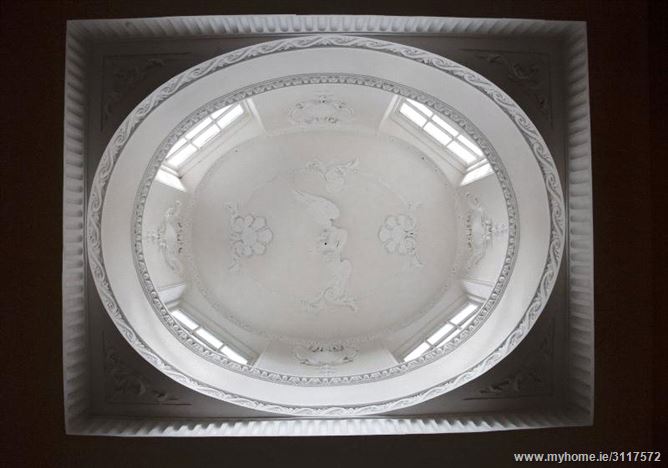John Coote's 18th century Bellamont Forest, Cavan Ireland ancestral trophy home relisted
Bellamont Forest near Cootehill, County Cavan, described by Mark Bence-Jones in A Guide to Irish Country Houses as "one of the most perfect examples of a Palladian villa", has been listed for sale.
There is an asking price of €1.35 million on the 18th century palladian villa.
It was Australian John Coote who bought back his ancestral home in 1987 for a reported IR£500,000, then restoring Bellamont before putting it on the market in 2010 with overly ambitious €7.5 million expectations.
Coote died suddenly in 2012, and the house is now for sale on the instructions of receivers for Coote's company, Thameside Holding, this time with its reduced price of €1.35 million.
Designed by Edward Lovett Pearce and built between 1725 and 1730, architectural historian Dr Maurice Craig (Country Life, 1964), wrote Pearce's design was based on Palladio’s Villa Rotonda at Vicenza and Villa Pisani at Montagnana.
The Irish National Trust, An Taisce, has noted the 290 year old building has been vacant for a number of years and "does not appear to be maintained."
Most of the external fabric remains, but there are obvious signs of deterioration, particularly water penetration.
"There is no immediate danger of collapse but the condition is such that unless urgent remedial works are carried out the building will sharply deteriorate," the Trust noted.
Bellamont Forest, the first Palladian house in Ireland, is set amid one thousand acres of parkland, woods and lakes, including sporting rights in the surrounding forestry.
It was built for Thomas Coote, Lord Chief Justice of Ireland, designed by his nephew, Sir Edward Lovett Pearce, whose other works include the former Houses of Parliament in College Green, now The Bank of Ireland.
He later became Surveyor General of Ireland, a post which he held until his death in 1733.
The house is four bays square, built over two storeys, with a basement. The internal floor area is approximately 1,032 square metres. The house is built of red brick with ashlar facings, and has a Doric limestone portico, with pediments over the windows.
Title Tattle especially loves the exquisite overhead oval cupola.

Bellamont Forest is 110 kms from Dublin and 75 minutes from Dublin International Airport, so listing agent Ganly Walters expect strong international buyer interest.
The late John Coote, the jetsetting international designer of Classical 18th-century houses, came from a notorious family.
The first to make his mark in Ireland was Sir Charles Coote, a military adventurer who died in battle at Trim, Co Meath, in 1642, leaving estates in four counties to his four sons. His youngest son, Col Thomas Coote, was granted the O’Reilly lands in Co Cavan at the Act of Settlement in 1662.
He married a Miss Hill from Hillsborough in Co Down and founded the town of Coote Hill (now Cootehill). On his death in 1671, his estate passed to his nephew, also Thomas Coote, who became a Lord Justice of the Kings Bench in Ireland, and was made a Knight of the Bath ‘in testimony of his good and laudable service in suppressing tumultuous and illegal insurrection in the northern parts of Ireland’. He also established Cootehill as a prosperous linen town.
On marrying his third wife, Ann Lovett, in 1697, Coote became the uncle-in-law of Sir Edward Lovett Pearce, a cousin of Vanbrugh, and by far the most important architect working in Ireland in the early 18th century.
Its name was later changed to Bellamont Forest by Coote’s grandson, Charles, who inherited in 1764 and became the Earl of Bellamont of the 2nd creation in 1767.
The new Lord Bellamont was a complex figure, being variously described as a man of ‘the highest refinement’, but also as a ‘tyrant’, ‘madman’ and ‘a person of disgusting pomposity’. An inveterate womaniser, he sired at least six illegitimate children, all of whom were provided for in his will. He was tried in 1764 for murdering a man during the 'Oakboy' rebellion which he helped to repress brutally. He got off and is immortalised in a camp portrait by Joshua Reynolds in the National Gallery.
On his death in 1800, the estate passed to these descendants who lived on at Bellamont Forest, becoming gradually ever poorer.
In 1874, Edward Smith JP, having amassed a considerable fortune from the coal trade between Liverpool and Newry, bought the Bellamont house and lands for £145,000. Following his death in 1880, the estate passed through various members of his family until 1984, when what Country Life described as the ‘troubles’ in the North finally persuaded the last of them to leave. The IRA had used the estate as a training ground.
Three years later, John Coote seized the chance to buy it.
It was listed in 2010 after Coote’s three children all returned to settle in Australia. John Coote, noting the architect spent three years in Italy in the early eighteenth century where he toured the Veneto and Palladio’s villas, thought La Rotunda was his great inspiration.
There was considerable sadness at John Coote's death given he was one of the great interior designers who buoyed Melbourne's property credentials, especially during the 1980s.
His Melbourne client list included the Lews, Foxes, Elliotts and Kimberleys.
His 1987 Corrie Perkin Good Weekend piece was headlined: "John Coote turns new money into old".
The Australian born, RMIT-trained, Pimlico Road, London interior designer was last in the local headlines during his divorce from Andrea Coote over the settlement of what was dubbed "Coote Castle."
The local paper noted this week that some months after Coote's death, Cavan County Council issued enforcement orders regarding the removal of marble busts from the house. The statues, which occupied alcoves in the entrance hall, depicted generations of old Cootes.
Their whereabouts are known.
